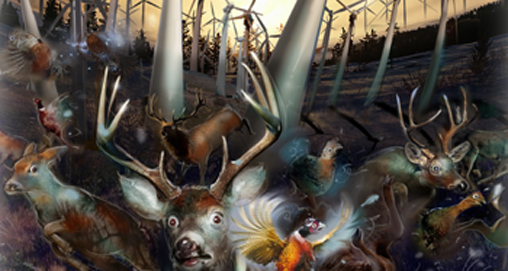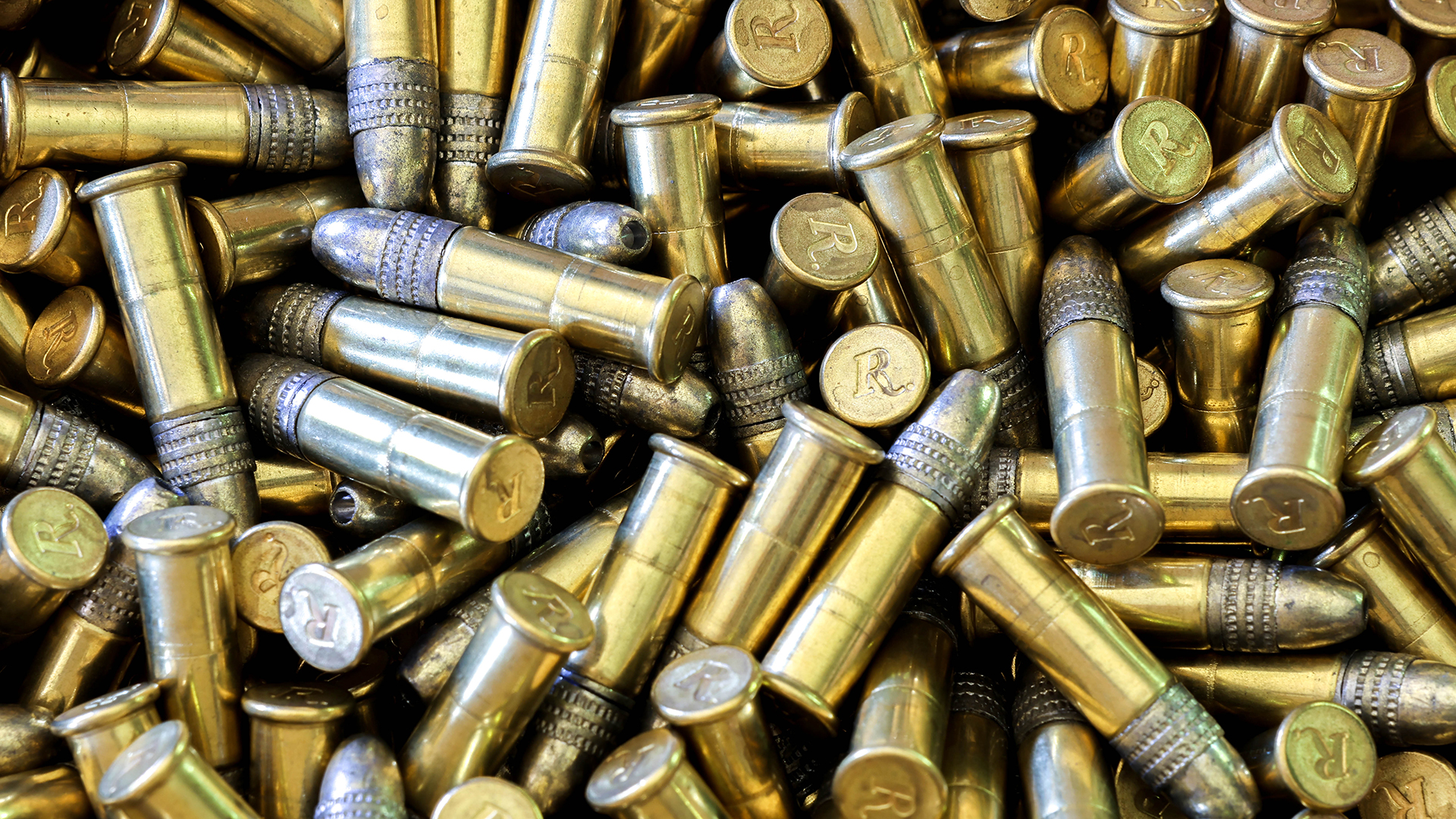
Walk onto a modern wind farm and you’ll feel like an ant in a field of sunflowers. Modern wind turbines stand 30-50 stories tall. Their blades swinging high above can be more than 130 feet long. Their steel towers are anchored in platforms of more than a thousand tons of cement and steel rebar, which are typically 30 to 50 feet across and anywhere from 6 to 30 feet deep.
Mountaintops have to be blasted flat to bear them. As you stand under one you’ll realize Don Quixote couldn’t have jousted with these giants, and then you’ll wonder if such leviathans are really all “green.”
Ken Salazar, the U.S. Secretary of the Interior, thinks so. He recently declared that the federal government’s goal is to generate 20 percent of U.S. electricity from the wind. Achieving this goal would require an estimated 186,000 giant wind turbines that would collectively cover an area the size of West Virginia. Those turbines would also require around 20,000 new miles of high-voltage transmission lines to carry the electricity from windswept landscapes to distant cities.
I began to wonder if there was a downside to wind development while hunting antelope on a ranch north of Casper, Wyo., last fall. I hadn’t been in this area of Wyoming for four years. In that time the landscape had sprouted forests of gigantic wind turbines. Sure, Western cattle ranchers and farmers have long since figured out that maintaining healthy game populations is a smart economic thing to do, as hunters pay well to roam where the deer and the antelope play. Such ranchers also rely on monies from oil and gas. In fact, a look around the ranch I was hunting on revealed methane wells and, not far away, oil derricks were pumping up crude. Wyoming is also the nation’s largest coal producer, with over 400 million tons of coal produced in the state each year. So taken together with newfound wind power, Wyoming encapsulates America’s multi-faceted quest for energy. But is this latest federally fostered craze all green?
My guide, Kelly Glause, owner of Cole Creek Outfitters, saw me looking at the wind turbines with bewilderment and joked, “Some say deer don’t like the high-pitched noise these monsters make. They say the windmills make a sound like the Save-A-Deer Whistle, you know that product that’s marketed to drivers to stop deer from crossing in front of their autos.”
He didn’t buy the silly theory, of course. And I later shot a mule deer within sight of churning wind turbines. What bothered Glause was that when the ranch he outfits on signed the deal to put up the turbines, the California company, which benefits from federal “stimulus” money and tax breaks, wanted the hunting on the ranch stopped. The wind company’s bureaucracy thought hunters would pass the time between stalking antelope by blasting away at the wind turbines. “They just had no idea what hunters really do for the environment,” said Glause. “I told them they’d have to compensate me for what I’d leased the ranch for as well as what I make in an average year from outfitting, and they backed off.”
So then, if politically correct wind farms get contracts to build on large tracts of federal lands, could public areas become de facto no-hunting areas at the ignorant insistence of wind-turbine companies?
Impacts of Wind Turbines
A dip in the Continental Divide in central Wyoming gives the Cowboy State nearly half of the country’s top-quality (class 5, 6 and 7) winds. So the good people of Wyoming get to make money from what used to be only a nuisance. But property rights, as well as state and federal land uses, are always hot topics out where hunting is a way of life. Even in the least-populated state, thousands upon thousands of 30-50 story turbines and all their miles of transmission lines generate heated debate. Rocky Mountain Power President Richard Walje told a congressional subcommittee on natural resources as much: “I have not met one person who has welcomed a transmission line on his property, and I doubt I would find anyone who would say, ‘Oh, the transmission line is only for renewable energy; in that case I’ll take two.’”
In fact, last spring, the Wyoming Game and Fish Commission acknowledged the impacts wind farms can have on wildlife habitat by approving new guidelines for wind-energy developers. The 70-page report includes a color-coordinated map of Wyoming that outlines where it thinks wind development should be curtailed, as well as where oil and gas development is and isn’t permissible.
Some Wyoming landowners have objected to the plan, saying the recommendations are an intrusion on their private-property rights. However, one reason Wyoming took the impacts of wind farms seriously is that over the past decade the prospect of the sage grouse being listed under the Endangered Species Act has loomed. A listing of the sage grouse as endangered could hit mining, ranching and energy in Wyoming as hard as the spotted owl’s listing slammed the timber industry in the Northwest—and it would unquestionably impact private-property rights. Indeed, in 2010, the U.S. Fish and Wildlife Service (USFWS) decided to add the sage grouse to a list of species that might be given more protections in the future.
Meanwhile, Wyoming Gov. Dave Freudenthal sent a letter to the state’s senate in which he wrote, “Seemingly every acre … is up for grabs in the interest of ‘green, carbon-neutral technologies,’ no matter how ‘brown’ the effects are on the land. It’s like taking a shortcut to work through a playground full of school children and claiming ‘green’ as a defense because you were driving a Toyota Prius.”
Freudenthal also argued that oil and gas developers have avoided prime sage grouse habitat, but, he wrote, “I cannot speak with the same certainty with regard to wind development.”
Some environmentalists have countered that oil and gas developers were there first so they wrote the rules of the game. Actually, the deeper you dig into this issue on the local level the more tilting at windmills you find. For example, Wyoming’s Senate is considering letting tax incentives for wind turbines sunset, local municipalities don’t always allow transmission lines and many conservation and environmental groups are only taking particular stances with regard to specific projects. In sum, on the local level in Wyoming, there is a robust and healthy debate underway on the merits of each proposed project and its potential impacts on wildlife in specific habitats.
Outside Wyoming
Federal mandates, however, seem more worrisome; after all, the federal government controls a large percentage of land in the West. Wyoming, for example, is 42.3 percent federally owned.
Thus, in September 2009 Sen. Lamar Alexander (R-TN) asked in an op-ed in The Wall Street Journal, “Is the federal government showing any concern about this massive intrusion into the natural landscape? Not at all.”
Criticisms such as Alexander’s prompted the USFWS to assemble a panel from groups and local governments to form the Wind Turbine Guidelines Federal Advisory Committee. This group of 22 people wrote a set of recommendations on how to minimize the impacts of land-based wind farms on wildlife for the Department of the Interior. The report, published last spring, determined, “The Committee recognizes that the environmentally friendly development of wind energy and the protection of the Nation’s natural resources are priorities for both the Administration and the American people.”
A year earlier, on March 11, 2009, Salazar had already issued Executive Order 3285, making “renewable energy a priority for the Department of the Interior.” In fact, despite serious debate about the science behind global warming, the advisory committee’s report also states, “Committee Members recognize that wind-generated electrical energy is renewable, and is considered to be a generally environmentally friendly technology … . Wind energy has recently received increased attention because … carbon dioxide emissions from fossil fuel combustion is the leading cause of anthropogenic climate change.”
The report also outlines a tiered set of criteria for approving sites for turbines. Federal lands comprise from 29.9 percent of Montana to 84.5 percent of Nevada, according to the U.S. General Services Administration. So the politics of this federal move could affect elk, mule deer and other game across public lands in the West.
Despite the current administration’s ideological predisposition, the potential impacts on ecosystems from “green energy” are getting some opposition from the left. For example, in August 2009 The Nature Conservancy published a paper titled “Energy Sprawl or Energy Efficiency: Climate Policy Impacts on Natural Habitat for the United States of America.” The report determined that nuclear energy is the least land-intensive, as it requires only 1 square mile to produce 1 million megawatt-hours per year, enough electricity for about 90,000 homes. To produce the same amount of energy, the report determined that geothermal energy requires 3 square miles, coal requires 4 square miles, natural gas needs 8, petroleum needs 18 and biofuels (corn and others plants) require up to 500. Wind farms require more than 30 square miles. In sum, green energy will require at least 128,002 square miles of new land to meet current goals by 2030, according to The Nature Conservancy.
“Let’s put this into perspective,” says Alexander, “we could line 300 miles of mountaintops from Chattanooga, Tenn., to Bristol, Va., with wind turbines and still produce only one-quarter the electricity we get from one reactor on one square mile at the Tennessee Valley Authority’s Watts Bar Nuclear Plant.”
Such projects, if only pushed by a president and his Department of the Interior, could hypocritically harm what they are being erected to protect if the local level isn’t involved in these decisions, as it has been on private lands in Wyoming.
In this surreal debate, perhaps it’s worth remembering that though it has been four centuries since Cervantes’ character Sancho pointed out to Don Quixote, “Look, your worship … what we see there are not giants but windmills, and what seem to be their arms are the vanes that turned by the wind make the millstone go,” we still must look at things honestly for what they are, not just for what our fantasies want them to be. This way our energy sources can evolve wisely on the local level, not by federal fiat, and we can continue to celebrate our role in the environment by hunting for what is certainly the most carbon-friendly meat of all, wild game meat.



































